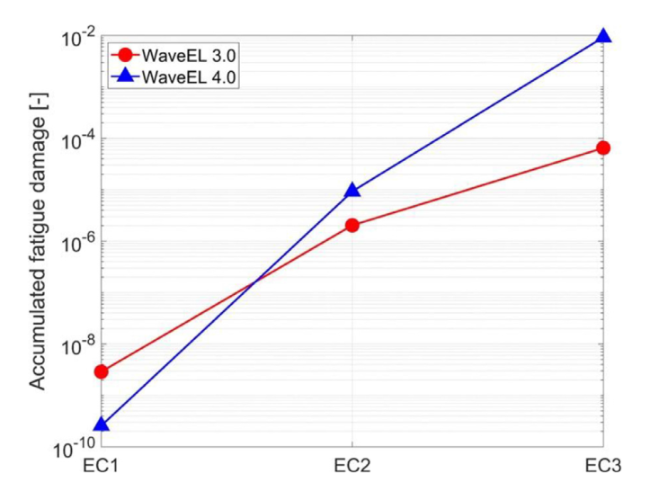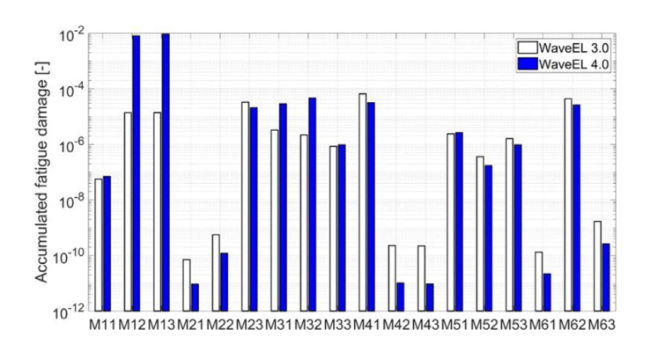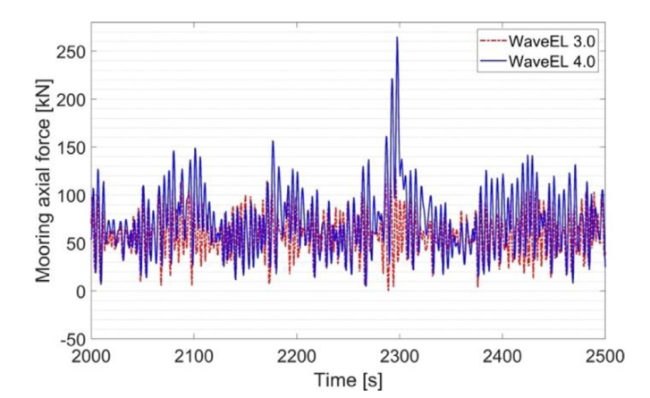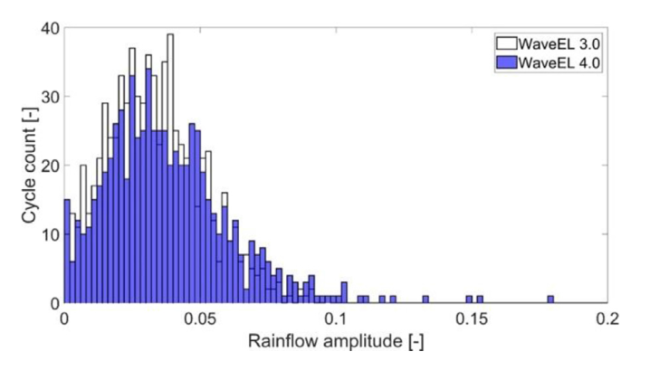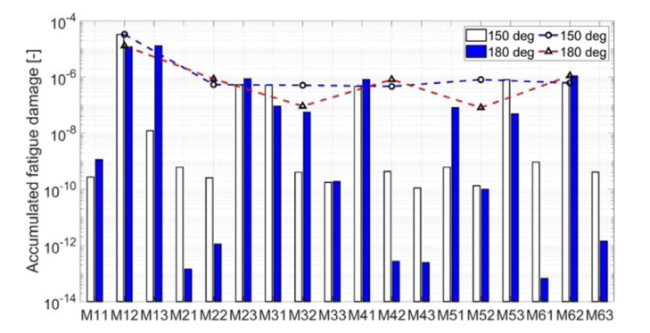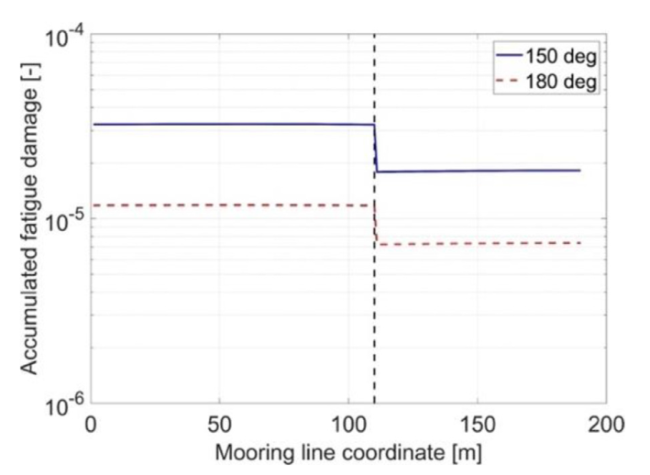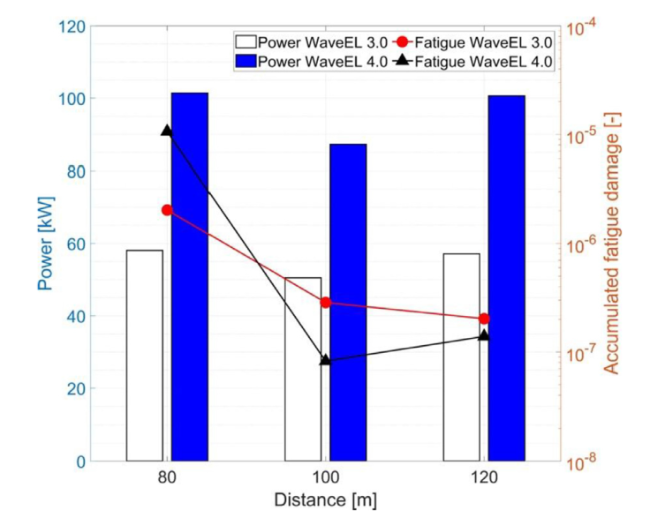1. Introduction
Fig. 1. (a) Schematic layout of the WaveEL 3.0 system, and (b) photograph of the full-scale installation in Runde, Norway. |
2. Simulation models and evaluation methods
2.1. Description of the WEC systems
Fig. 2. (a) WaveEL 3.0, and (b) WaveEL 4.0. |
Fig. 3. (a) Mooring line configuration, and (b) the shape of the upper part and mooring line fixing locations. The protruded grey blocks indicate the fairleads. |
Fig. 4. Profile view and geometrical dimensions of (a) the WaveEL 3.0 and 4.0 WEC buoys, and (b) the floater [m]. |
Table 1. Basic properties of the WaveEL WEC systems. |
| Property | WaveEL 3.0 | WaveEL 4.0 |
|---|---|---|
| Mass, Mw [kg] | 140.0 × 103 | 217.0 × 103 |
| Draft, Dw [m] | 15.3 | 42.0 |
| Centre of gravity, COGw [m]a | −1.9 | −10.6 |
| Roll inertia relative to COGw, Ixx [kg × m2] | 2.55 × 106 | 5.79 × 107 |
| Pitch inertia relative to COGw, Iyy [kg × m2] | 2.55 × 106 | 5.79 × 107 |
| Depth of the anchor [m] | 50.0 | 50.0 |
| Radius of the anchor [m] | 160 | 160 |
| Height of the fairlead (from still water level) [m] | 1.0 | 1.0 |
| Pretension force at the fairlead [N]b | 47.0 × 103 | 47.0 × 103 |
| Dry mass of each mooring section [kg/m] | 4.900 | 4.900 |
| Submerged weight of each mooring section [N/m] | 35.868 | 35.868 |
| Nominal diameter of each mooring section [m] | 0.08 | 0.08 |
| Axial stiffness of mooring sections [N] | 701.671 | 701.671 |
| Length of section 1 [m] | 105.0 | 105.0 |
| Length of section 2 [m] | 40.0 | 40.0 |
| Mass of the floater [kg]c | 2700 | 2700 |
| Height of the floater [m] | 3.6 | 3.6 |
| Volume of the floater [m3] | 9.0 | 9.0 |
| Power Take Off (PTO) system damping, BPTO [N × s/m] | 40.0 × 103 | 50.0 × 103 |
aThe origin of the reference Cartesian coordinate is placed in the plane of water surface at the geometric centre of the WEC buoy, when it is in its unloaded neutral position. bStill water conditions. cThe COG of the floater is located at the geometrical centre of the floater. |
Fig. 5. Axial load of the polyester mooring varying with relative elongation, from Yang et al. [17]. |
2.2. Description of the numerical model
2.3. Array layout of wave parks
Fig. 6. The Hex1 array layout was proposed by Shao et al. [5]: (a) top view, and (b) side view. The yellow circular markers containing numbers represent the wave energy converters, the blue diamonds represent the anchors, and the small green dots represent the floaters. Each mooring line is numbered. Two wave incoming directions 180° and 150° are also indicated. |
2.4. Environment load conditions
2.5. Analysis of power performance, hydrodynamic efficiency, and fatigue
3. Results from single-unit WEC simulations
3.1. Frequency-domain analysis
Fig. 7. Results from frequency-domain simulations: heave amplitude response per unit wave height with respect to wave periods. |
3.2. Time-domain analysis for regular waves
Fig. 8. Heave motions at different wave periods (T) and wave amplitudes (Ha). |
Fig. 9. The axial force in the upper rope (section 1) of mooring 1 at different wave periods (T) and wave amplitudes (Ha). |
Fig. 10. Power produced by (a) WaveEL 3.0, and (b) WaveEL 4.0. |
Fig. 11. Efficiencies of (a) WaveEL 3.0, and (b) WaveEL 4.0. |
Fig. 12. Comparison of the efficiencies between the WaveEL WECs with others available on the market. |
3.3. Time-domain simulations for irregular waves
Table 2. Sea state conditions (long-crested waves), from Ringsberg et al. [15]. |
| Date and time | Hs [m] | Tp [s] | θ [deg] |
|---|---|---|---|
| 2017-06-16 10:00-13:00 | 0.95 | 10.00 | 30 |
| 2017-06-18 08:00-11:00 | 1.40 | 6.75 | 30 |
| 2017-06-19 15:00-18:00 | 1.75 | 7.50 | 30 |
Fig. 13. The time-averaged axial force in the upper rope (section 1) of mooring 1. The measurement data are for WaveEL 3.0. |
Fig. 14. The time-averaged axial force in the upper rope (section 1) of mooring 2. The measurement data are for WaveEL 3.0. |
Fig. 15. The time series of the axial force in the upper mooring lines (section 1) of moorings 1 and 2 under the sea state condition of 2017-06-18: (a) WaveEL 3.0, and (b) WaveEL 4.0. |
Fig. 16. The time series of motions in three directions under the sea state condition of 2017-06-18: (a) WaveEL 3.0, and (b) WaveEL 4.0. |
Fig. 17. WEC buoy locations at the sea state condition of 2017-06-16 recorded in (a) the horizontal water surface, and (b) the vertical plane parallel to the incoming wave direction. |
Fig. 18. WEC buoy locations at the sea state condition of 2017-06-18 recorded in (a) the horizontal water surface, and (b) the vertical plane parallel to the incoming wave direction. |
Fig. 19. WEC buoy locations at the sea state condition of 2017-06-19 recorded in (a) the horizontal water surface, and (b) the vertical plane parallel to the incoming wave direction. |
4. Results from wave park simulations
Table 3. Definitions of three sets of environment conditions, and the probabilities of their occurrence (%) at the Runde test site. |
| EC | Significant wave height [m] | Wave period [s] | Wavelength [m] | Occurrence probability [%] |
|---|---|---|---|---|
| EC1 | 0.5 | 4.5 | 31.6 | 6.84% |
| EC2 | 1.5 | 5.5 | 47.2 | 10.14% |
| EC3 | 3.5 | 7.5 | 87.8 | 5.63% |
4.1. Effects of environment conditions
Fig. 20. Accumulated fatigue damage of the ‘weakest link’ of all mooring lines of arrays (WEC distance = 80 m) with different WEC versions and environment conditions; see the text for definitions and details. |
Fig. 21. Accumulated fatigue damage in each mooring line for two arrays (WEC distance = 80 m) with two WEC versions under EC3. |
Fig. 22. Mooring axial force time series of M12 in two versions of WEC array. |
Fig. 23. Rainflow amplitude count of relative tension in M12 of the WaveEL 4.0 array under EC3. |
Fig. 24. (a) x-axis (surge) motion, and (b) z-axis (heave) motion of WEC 1 in Fig. 6 under EC3. |
4.2. Effects of incoming wave direction
Fig. 25. The accumulated fatigue damage of each mooring line in the WaveEL 4.0 array with incoming wave directions of 150 and 180° under EC2. The lines show the accumulated fatigue damage of each WEC unit. |
Fig. 26. M12 accumulated fatigue damage along the mooring line coordinate when the incoming wave direction is 150 and 180°. The parts of the coloured lines to the left of the black dashed vertical line represent the accumulated fatigue damage of section 1; the parts to the right represent section 2. |
4.3. Effects of WEC distance
Fig. 27. The accumulated fatigue damage and hydrodynamic power output of WEC arrays with different WEC distances. |





















